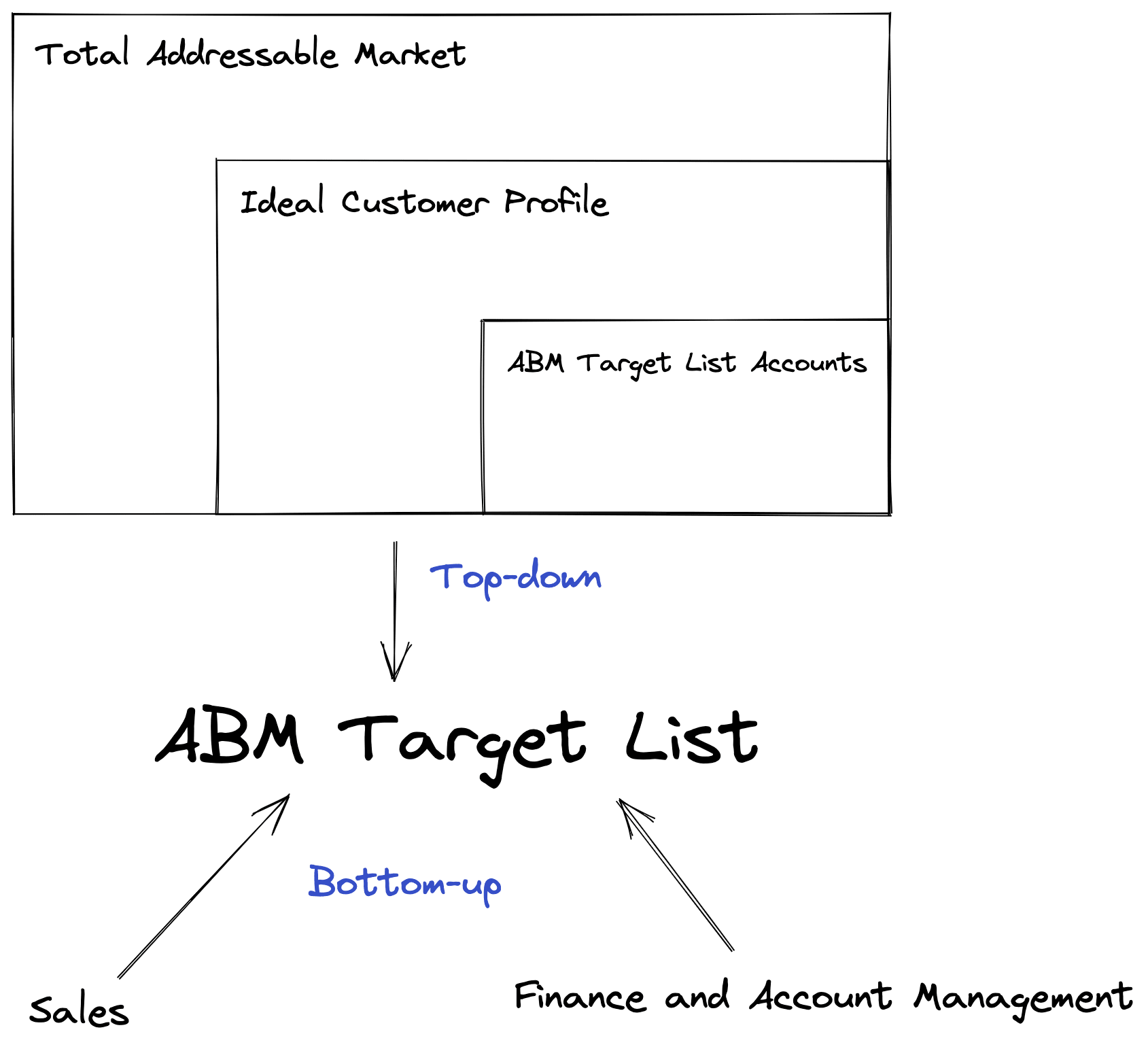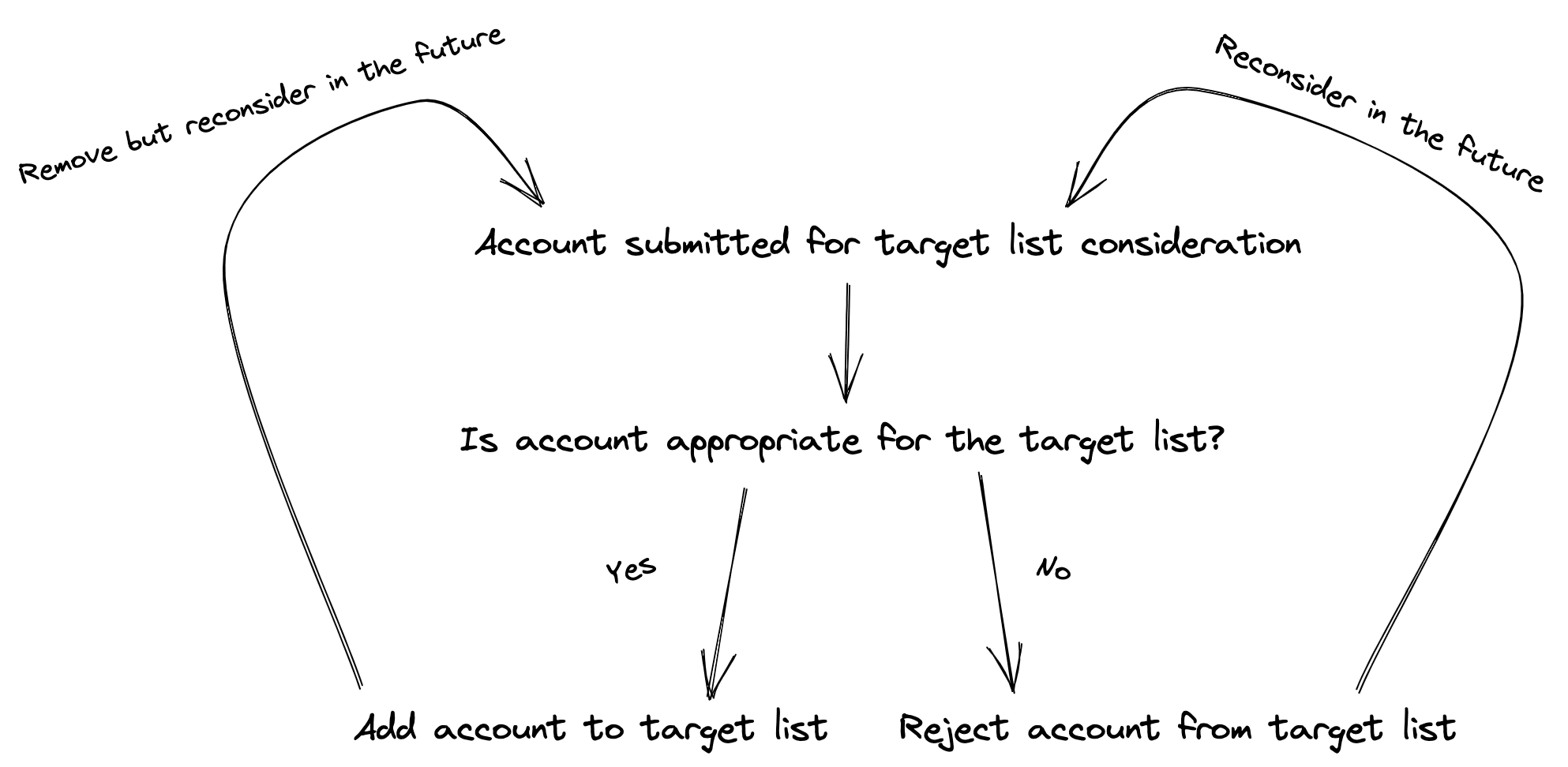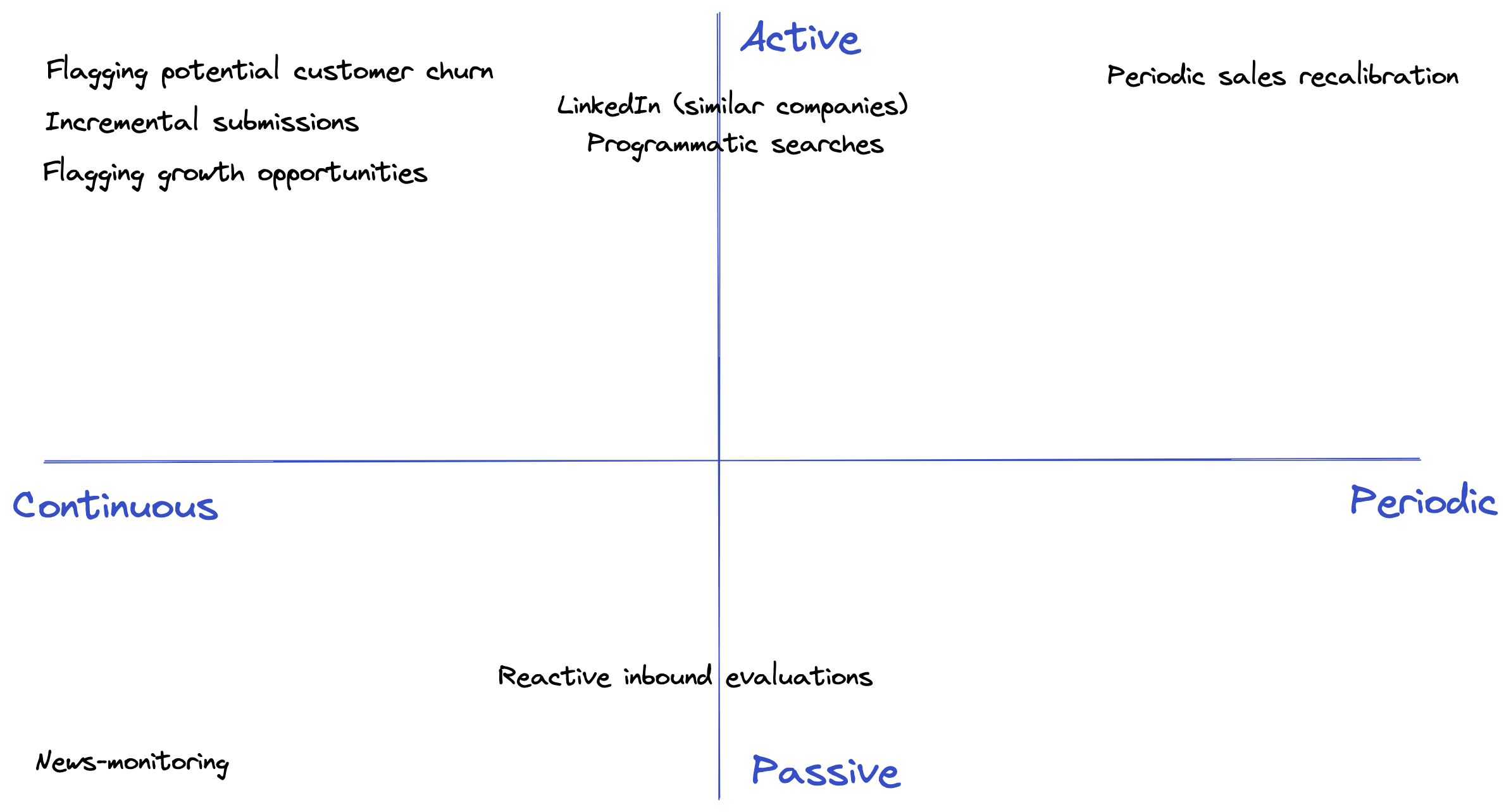Building and maintaining ABM target lists - Part 1
∙ 9 min
Account-based marketing holds a lot of promise. In my mind, it’s the most logical way to approach enterprise B2B marketing. Executed correctly (and I cannot stress this enough), it brings focus and alignment to your entire growth organization (marketing, sales and account management). However, a lot of advice online glosses over the organizational challenges of implementing a successful account-based approach. I’ll be writing a series of articles to add a practitioner’s perspective to things. Let’s start with the topic of target lists.
Let’s go through some important considerations I’ve learned over the years about how to create and maintain a solid target list. Your target list is the entire backbone of your account-based program, so it’s worth getting right. And getting it right requires a mix of a logical approach with organization pragmatism.
List formation
I’ve found there are several ways to start to get a list together. And none of them in isolation will be sufficient. The sum of their parts is where the magic happens.
Ideal Customer Profile
Whether you’re considering ABM a viable marketing strategy or not, it’s pretty critical to discuss internally what your ideal customer profile (ICP) looks like. And here, I don’t mean buyer personas - I mean account profile. Oftentimes person-level personas are conflated with account characteristics. Don’t make that mistake: start at the account level and then move on into the buying team personas.
Nailing down what your ICP is can actually be a complex and exhausting process, with lots of internal stakeholders to consider and consult and lots of their opinions to unify. But it’s a worthwhile exercise because it gives you a starting point to better size up the next two sources of target accounts: what your revenue numbers say and what your sales team thinks. Combining this top-down and bottom-up approach is a lot like market sizing: if something is totally off when you compare the two approaches, ask yourself why. Otherwise, pragmatically merge everything and that’s your starting point.
Analysis of current customers and identifying the gems
Find the department in your company which can identify the most successful customers for your products or services. This might be sales, it might be account management or finance. Or a combination thereof. Your ability to sell to those happy customers at healthy margins implies product-market fit. The findings of this process shouldn’t come as a great surprise, as the company probably already has a good idea of who these customers are.
This is where you have to start asking clear questions about what makes these customers unique amongst the less-lucrative customers. Don’t fall into the trap of seeing what you want to see, based on your preconceived opinion of your ideal customer. This is where you have to dispassionately identify common traits. You’ll be able to query an account database along some of those traits (like geography of headquarters, number of employees, sector/industry or revenue), but many others (and likely the most important ones) won’t fit into such categories. This list of criteria here is endless, but some things I’ve seen in past ABM implementations are:
- recent major re-organizationss or acquisitions
- a new appointment in a relevant buyer role
- the amount of value they place on their brand
Those are all attributes you’ll unlikely be able to input into a search field, but they could be critical in recalibrating you Ideal Customer Profile. And what this also means, depending on the criteria you determine, is that your target account list can become very dynamic, with seemingly good-fit companies falling off the list because something material recently changed.
Excel lists on C: drives
I can almost guarantee you that most or all members of your sales team maintain their own personal target account lists somehow. Excel, a notebook, wherever. These are accounts they’ve compiled and reflect their opinion of where they have the best chances of winning. They’re paid on commission, after all, so why should they wait for someone to hand them a list of target accounts before they go start finding their newest customer?
These lists are great sources of target account names because they should implicitly be aligned to where the salespeople think they can most likely win. This is, however, a great place to work with sales management to get the whole sales team aligned, in case multiple salespeople are eyeing the same accounts or if some salespeople are going rogue on who they’re targeting.
It’s a delicate task to ask an entire sales team to hand over their target list for all-up alignment, so I suggest working closely with sales management so it can be messaged properly: if marketing is aligned to what sales is chasing, they can deploy tactics that can only help the salespeople’s chances of closing new business.

Distinguishing between marketing qualified accounts and ABM target list accounts: the latter is a subset of the former. You’ll have to make a judgement call what you consider to be marketing qualified (whether it’s everything meeting your ICP or if you expand that out into your total addressable market).
Harmonize
There is no magic trick to what comes next. You simply need to compile these sources into one, and track which account came from which source. Chances are multiple salespeople will consider the same account a good target account, so track that in your harmonized list. Use something like a tag/label or multi-select dropdown field to denote the source of the account. This will help you resolve any conflicts and give clear ownership of a target account to one and only one salesperson.
Just start. Iterate. Present and discuss. Iterate again. I know if can feel daunting and you’ll likely go back and forth a lot between stakeholders, tactical and strategic, but this is a worthwhile and necessary step.
List sanitization and expansion
An ABM target list is a living, breathing set of data. Accounts can be:
- submitted and subsequently rejected from joining the target account list
- submitted and subsequently accepted into the target account list
- if already on the target account list, removed from said list
I suggest finding a way to track the history of this at the account object level of your CRM. If you considered an account in the past and decided it’s not a good fit, you’ll want to note that and not repeat that evaluation (and associated debate) in the future or have a meaningless discussion/debate about why it’s not there. There’s no way you’ll remember you rejected it if the question comes up and you didn’t document this.

Marketing-led
- Programmatic searches: Marketing can scour databases like Hoovers (or countless others) to constantly add new accounts to the target list which match your criteria (at least, those criteria which can be used to query a database)
- LinkedIn (similar companies): I’ve found it’s really helpful to navigate to a target account’s Company Page and have a look at other companies users view, via LinkedIn’s recommendation engine (by clicking
See all similar pages). For example, if ActiveCampaign is a target account, navigate to their LinkedIn Company Page and you’ll likely be shown other players much like them (HubSpot, MailChimp, etc…). - Good old fashion news-monitoring: As stated above, you’ll likely see that some of your ideal customer profile criteria are simply not parameters you can type into a database query. Set up monitoring of press releases and news outlets for keywords that match those criteria, and do your detective work. You can set notification in Google Alerts or explore solutions like Feedly for this.
- Reactive inbound evaluations: Inbound conversions should prompt you to both check for marketing qualification of the inquiring account and also considering it automatically for the target account list.
Sales-led
- Periodic sales recalibration: I recommend setting monthly, quarterly or semi-yearly target list review sessions with all your major stakeholder groups. These can be intense meetings, but they can also be done asynchronously with larger sales teams and maybe 1:1 with the sales leadership. Since this is an event, it will prompt some reflection on what the last quarter taught you about the accuracy of the target list, and which accounts need to be removed and which added. This is realistically the only time any significant amount of accounts will be removed from the list, so take the opportunity to ruthlessly clean up the list and dump the accounts that don’t make sense anymore.
- Incremental submissions: Periodic reviews of the list alone don’t provide the sales team with enough agility to react to something they see in the market. If they’ve come in contact with information that suggests an account needs to be added to the target list, it’s your job to give them an elegant way of submitting that account for addition to the list.
Account management-led
- Flagging potential customer churn: Account management teams can flag accounts that are considering bidding you farewell for your competition. This is a great opportunity to discuss what marketing can do to support the retention of that account, if anything at all. Adding that account to the target list will unlock marketing resources to combat the churn…but if there are delivery problems, no amount of marketing will fix that.
- Flagging growth opportunities: Those same account management teams can flag accounts that are ripe for expansion. Often in enterprise sales, the beachhead strategy prevails: land-and-expand. This means that this source of promotion of customer accounts to the ABM target list isn’t a “nice to have”, it’s an absolute must if you’re going to deliver on that growth strategy.

Don’t make the mistake of thinking Account-based Marketing is only for acquiring new customers. It’s simply not. It’s ideal for growing share of wallet in your existing customers and expanding to adjacent divisions, departments and geographies.
Closing thoughts
Getting your arms around how to start and how to maintain an ABM target list is absolutely critical to the success of your account-based approach. Do don’t put up with ambiguity in the process and don’t be afraid to get your hands dirty while doing it.
Build rituals into how you work across all these stakeholder groups. At the beginning it feels heavy on overhead, but after a while everyone will get used to it, things will go faster and alignment is inevitable.
In the next article on Building and Maintaining ABM Target Lists, I’ll dive deeper into some critical considerations of target list metadata and how it enables you navigate ABM across diverse groups of stakeholders in the company. And I’ll share some best practices to make your list as future-proof and maintainable as possible.
